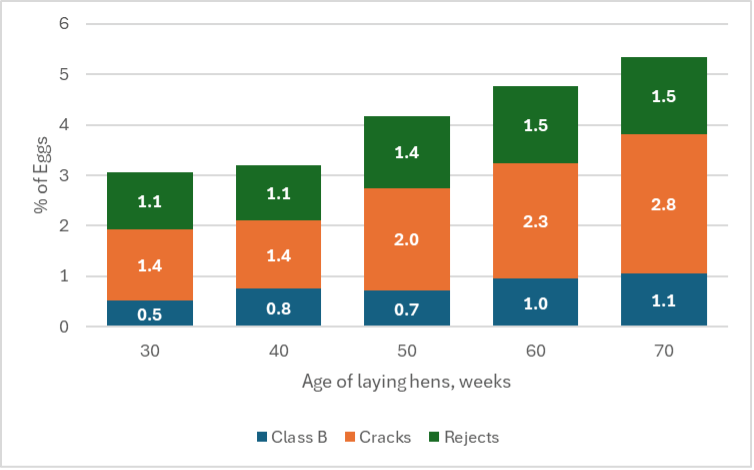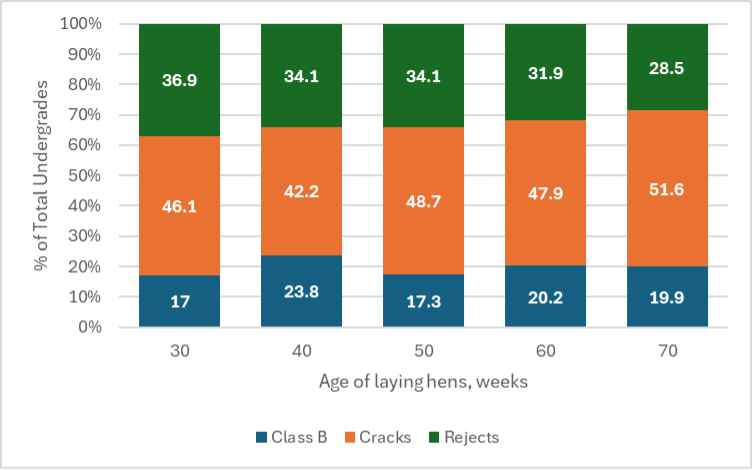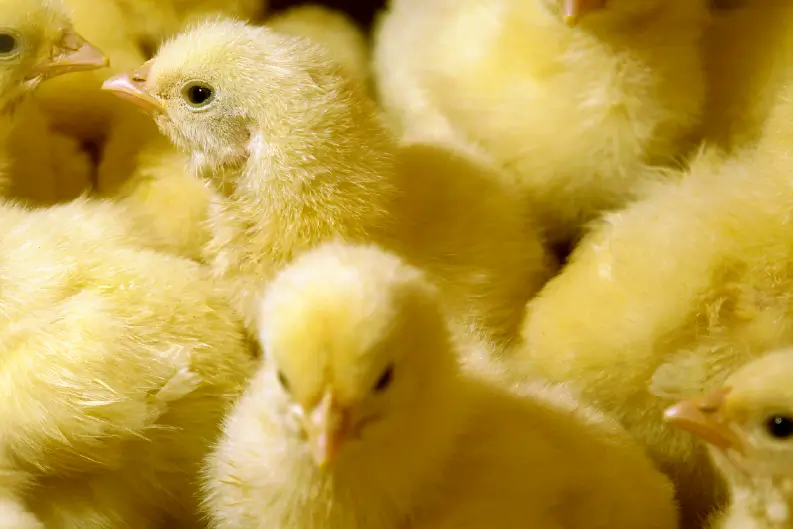By: Tanka Khanal, Ph.D., DVM,
Monogastric Nutritionist
Grand Valley Fortifiers
In Canada, the egg consumption per capita has increased by more than 30% over the last decade (2012 to 2022). If we look at 2022, more than 1200 registered egg producers in Canada produced more than 2.32 million dozen of eggs daily on average. Unfortunately, not all eggs produced are of the same quality and undergrade eggs are one of the major problems of the Canadian egg industry.
Egg Grade out in a Canadian Context
Graders in Canada categorize eggs in nine different grades: jumbo, extra-large, large, medium, small, peewee, class B, cracks, and rejects. Class B, cracked, and rejected eggs are combined to give total undergrades and account for about 3-5% of total egg production (Figure 1). The cracks contribute a major proportion of undergrades, ranging from 40 to 60% of the total undergrades, followed by rejects and then class B (Figure 2). The cracks and rejects (C+R) contribute more than 80% of total undergrades. Therefore, this article will focus on how to control cracks and rejected eggs through layer nutrition.

Figure 1: Breakdown of undergrade eggs as a percent of total egg production based on hen age, (n = 17500 dozen eggs, GVF Customers, 2023).

Figure 2: Contribution of each undergrade category towards total undergrades, (n = 17500 dozen eggs, GVF Customers, 2023)
Nutrition plays a significant role in controlling cracks and reject eggs. Part I of this series will cover calcium utilization by hens for eggshell quality, which eventually lowers the total undergrades. Calcium utilization will be covered in relation to applying the concepts of limestone particle size distribution, its impact on fractional passage rate of calcium from gizzard to duodenum, calcium digestion and absorption, and vitamin D3 activity on active calcium utilization. Part II of the series will discuss other aspects of nutrition that contribute to eggshell strength.
Enhancing Calcium Utilization Through Limestone Particle Size Distribution
In general, the limestone particle size is maintained through the specified ratio of fine to coarse limestone. A nutritionist should also focus on distribution pattern of limestone particle size in the given limestone type. Determining the limestone particle size distribution, and adjusting the ratio of fine to coarse limestone accordingly, could give a better ratio of fine to coarse limestone. The particle size distribution will affect the fractional passage rate of calcium from the gizzard to duodenal loop and will significantly affect the calcium utilization from intestine to uterus during active eggshell formation process during the night. Better calcium utilization will impact eggshell thickness, breaking strength, and eventually crack percentage. Limestone particle size is not the only factor influencing calcium utilization. The activity of vitamin D3 must also be considered.
Understanding the Role of Vitamin D3 in Late Lay
Vitamin D3 is an essential nutrient to optimize calcium (directly) and phosphorous (indirectly) utilization in laying hens. Vitamin D3 improves apparent retention of calcium. Poor eggshell quality and eventually higher undergrades are due to a larger proportion of cracks in the late lay phase, which is a common problem in the Canadian egg industry. Addition of extra vitamin D3 could enhance performance, fix temporary abnormal gait, and enhance eggshell thickness and breaking strength. Now, an important question is “How much of vitamin D3 or activated vitamin D3 (25 hydroxycholecalciferol, 25OHD3) is required to get a better result when there is incidence of poor eggshell quality?” The answer to this question depends on the level of vitamin D3 in the current diets. If vitamin D3 level in the current diet is less than 4000 IU/kg of the complete ration, supplementing an extra 5000 IU/kg (125 μg/kg) of vitamin D3 or activated vitamin D3 for a short period (1.5 -2 weeks) improves performance, eggshell quality, and cracks.
Conclusion
The per capita consumption of eggs by Canadians has increased over the last decade and that trend is continuing. Persistent lay with better grades out is one of challenges of our egg industry and nutrition plays a vital role in reducing poor grading eggs. When considering calcium supply for eggshell quality and undergrade eggs, it is important to consider the distribution of limestone particle size, rather than only the ratio of fine to coarse limestone in formulation. Determining limestone particle size distribution and adjusting the ratio of fine to coarse accordingly could give a better supply of calcium for eggshell formation. Better utilization of calcium through vitamin D3 fortification could also provide better eggshell quality and could significantly prevent structural bone mineral loss. Supplementing extra vitamin D3 or activated vitamin D3 for a short period at regular intervals could be a practical application to improve undergrades.
This article was written for the Spring 2024 Poultry Grist. To read the whole Poultry Grist, click the button below.

